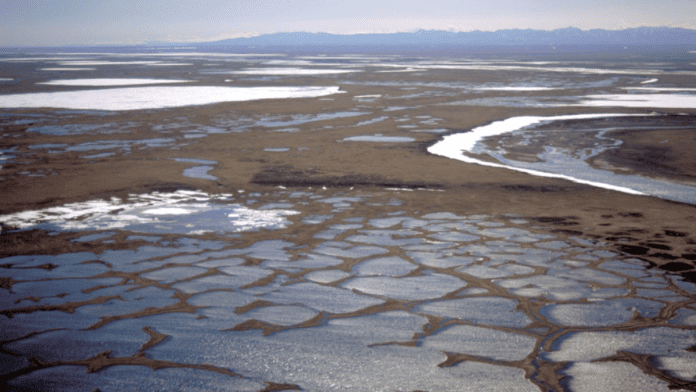🕒 Last updated on October 27, 2025
The Trump administration, led by President Donald Trump, has taken a major step by finalising a plan to open parts of Alaska’s Arctic National Wildlife Refuge to oil and gas drilling. This decision, announced by U.S. Interior Secretary Doug Burgum, reignites one of America’s most heated debates — whether to prioritise economic growth or protect one of the most untouched natural areas in the country.
The Arctic National Wildlife Refuge, often called ANWR, covers a massive area of northern Alaska. It is home to polar bears, caribou, and many bird species that migrate from around the world. The coastal plain of this refuge, now approved for drilling, spans over 630,000 hectares of land. For decades, this area has been considered sacred by nearby Indigenous communities who depend on its wildlife for food and cultural traditions.
According to the Interior Department, the move allows future lease sales for oil and gas exploration within the coastal plain. This fulfils promises made by President Trump and congressional Republicans to open the area for development and energy production. Supporters, including Alaska Governor Mike Dunleavy, believe this step could bring more jobs, income, and opportunities for Alaska’s economy, which has long relied on natural resources.
Voices from Alaska’s Communities
People in Alaska are divided on this issue. Indigenous communities near the refuge have expressed very different opinions about the plan. Some groups, such as the Gwich’in people, see the land as sacred and fear that drilling will harm the caribou herds they depend on for food and tradition. They believe the noise, pollution, and movement of heavy machines could drive the animals away from their calving grounds. For these communities, protecting the refuge is about preserving a way of life passed down through generations.
However, other local residents, especially from the Iñupiaq village of Kaktovik, support the drilling. Charles “CC” Lampe, President of the Kaktovik Iñupiat Corporation, said the new plan respects local voices and supports long-term success. He and others argue that responsible oil development can bring much-needed jobs and help their community grow. They believe that with strict safety and environmental rules, drilling can happen without destroying the land.
Alaska’s state leaders, including Governor Dunleavy and members of the state’s congressional delegation, have also backed the decision. They say it represents a chance for Alaska to take control of its own resources and boost the local economy. They have long argued that modern drilling methods can be safer and cleaner than before. Still, many environmental groups, such as The Wilderness Society, remain strongly opposed. Meda DeWitt, the group’s Alaska senior manager, said the government is placing corporate profits above the lives and cultures of people who depend on the Porcupine caribou herd.
This is not the first time the Arctic Refuge has faced such a plan. Previous administrations have gone back and forth on the issue for decades. Some allowed exploration, while others, including the Biden administration, blocked it to protect the environment. The debate continues to divide Alaskans and Americans across the country.
Another Controversial Move: The King Cove Roa
Alongside the drilling announcement, Secretary Burgum also approved a plan to build a road through another protected area — the Izembek National Wildlife Refuge. The road would connect the isolated community of King Cove with the nearby town of Cold Bay. Residents have long pushed for this connection, saying it is needed for medical emergencies, as the nearest hospital is many miles away and weather conditions often make air travel dangerous.
Big oil’s shadow network pumped millions into Charlie Kirk’s culture war machine
The government completed a land exchange deal that would allow construction of this road. Supporters say it is a matter of life and safety, not just convenience. They believe the road will finally give residents year-round access to an airport and emergency care. However, environmental groups and some tribal communities are against the move. Cooper Freeman, Alaska director at the Center for Biological Diversity, said his organisation plans to challenge the decision in court, warning that it could harm migratory bird populations and destroy “ecologically irreplaceable” wilderness.
The Izembek Refuge is world-famous for its wetlands, which serve as resting grounds for birds traveling thousands of miles each year. Conservationists argue that allowing development here could set a dangerous precedent for opening other protected areas to construction or commercial use. They plan to challenge the decision in court, saying it breaks past promises to preserve wilderness lands for future generations.
Senator Lisa Murkowski, who has long supported the project, said the King Cove road is about saving lives, not building an industrial highway. She noted that the plan calls for an 11-mile, one-lane gravel road designed for noncommercial use. Despite those assurances, opposition groups fear that once construction begins, it will open the door to more projects in sensitive habitats.
The decisions on the Arctic Refuge drilling and the King Cove road mark significant changes in federal land policy. They reflect an ongoing struggle between those who seek economic opportunity from Alaska’s vast resources and those who wish to protect its unique and fragile environment. The debate is expected to continue in courtrooms, communities, and across the nation for months to come.

